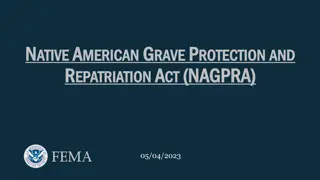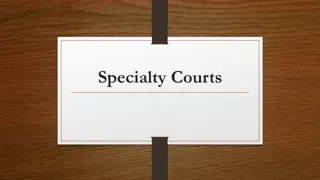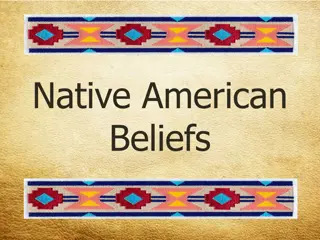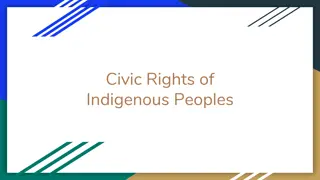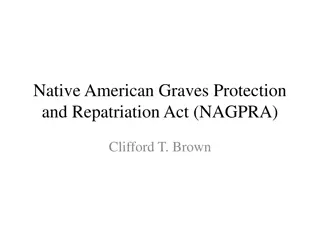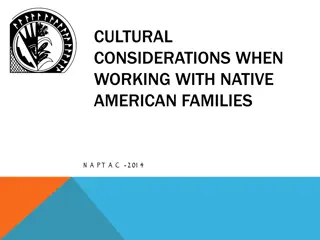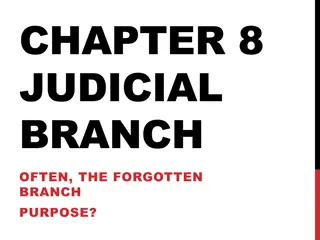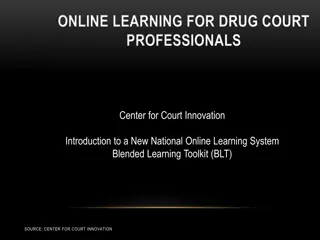Cultural Awareness for Drug Courts Working with Native American Participants
Understanding the cultural nuances of Native American communities is crucial for Drug Courts collaborating with Tribal Healing to Wellness Courts. This involves acknowledging tribal sovereignty, regional and cultural differences, customs, spirituality, and communication styles unique to American Indian/Alaska Native groups. By embracing cultural awareness, Drug Courts can enhance their interactions and support for Native American participants effectively.
Download Presentation

Please find below an Image/Link to download the presentation.
The content on the website is provided AS IS for your information and personal use only. It may not be sold, licensed, or shared on other websites without obtaining consent from the author. Download presentation by click this link. If you encounter any issues during the download, it is possible that the publisher has removed the file from their server.
E N D
Presentation Transcript
What Drug Courts Need to Know About Native American Participants and Collaborating with Tribal Healing to Wellness Courts O K L A H O M A S T A T E W I D E D R U G C O U R T T R A I N I N G S E P T E M B E R 2 7 - 2 8 , 2 0 1 2 T R I B A L L A W A N D P O L I C Y I N S T I T U T E P R E S E N T E R S : C H A R L E N E J A C K S O N D I A N N E B A R K E R H A R R O L D D O N N A H U M E T E W A K O R E Y W A H W A S S U C K L A U R E N F R I N K M A N
A Guide to Build Cultural Awareness American Indian/Alaska Native Myths and Facts: Tribal Sovereignty: Presently, there are more than 560 Federally recognized AI/AN tribes in the US. There is a unique legal and political relationship between the Federal government and Indian Tribes Regional and Cultural Differences: Historic rivalries, family or clan conflicts and Tribal Politics may present challenges for an outsider unaware of local dynamics who is trying to interact with different groups in the community. Urban Indian communities can be found in most major metropolitan areas.
A Guide to Build Cultural Awareness American Indian/Alaska Native Cultural Customs: Specific cultural customs among AI/AN groups may vary significantly, even within a single community. Deeply held values, general world view, patterns of communication, and interaction are often the differences that affect the helping relationship. Respectful questions about cultural customs are generally welcomed, yet not always answered directly. Sharing food is a way to welcoming visitors, similar to offering a handshake.
A Guide to Build Cultural Awareness American Indian/Alaska Native Spirituality: Many AI/AN communities have strong church community and organized religion that is integrated with their culture. Traditional spirituality and practices are integrated into AI/AN cultures and day-to-day living. Specific practices such as ceremonies, prayers, and religious protocols will vary among AI/AN communities It is common practice to open and close meeting with a prayer or short ceremony.
A Guide to Build Cultural Awareness American Indian/Alaska Native Communication Style: AI/AN people communicate a great deal through non-verbal gestures. AI/AN people may convey truths or difficult messages through humor. It is often considered unacceptable for an AI/AN person to criticize another directly. Getting messages across through telling a story (traditional teachings and personal stories) is very common.
A Guide to Build Cultural Awareness American Indian/Alaska Native Cultural Identity: It is important to understand that each person has experienced their cultural connection in a unique way. Many AI/AN families are multicultural and adapt to their surrounding culture. It is important to remember that most Alaska Natives do not refer to themselves as Indians.
A Guide to Build Cultural Awareness American Indian/Alaska Native Role of Elders and Veterans Elders play a significant role in Tribal Communities. It is customary in many Tribal communities to show respect by allowing elders to speak first. In group settings, people will often ask the elder s permission to speak publicly, or will first defer to an elder to offer an answer. Veterans are also given special respect similar to that of elders for having accepted the role of protector and experienced personal sacrifice.
A Guide to Build Cultural Awareness American Indian/Alaska Native Health and Wellness Challenges: Prevention and intervention efforts must include supporting/enhancing strengths of community resources as well as individual and family clinical interventions. Service providers must take great care in the assessment process to consider cultural differences in symptoms and health concepts when making a specific diagnosis or drawing conclusions about the presenting problem or bio-psychological history. Every effort should be made to consult with local cultural advisors for questions about symptomology and treatment options.
A Guide to Build Cultural Awareness American Indian/Alaska Native Historic Distrust Establishing trust may be difficult due to historical events and policies. 1800s 1960s: Government Boarding Schools 1950s 1960s: Federal Termination Policy and Relocation Policy Cultural & Religious Suppression: Today, there is a diverse mix of Christian beliefs and traditional spirituality within each AI/AN community. Historical Trauma: Cumulative emotional and psychological wounding over the lifespan and across generations.
A Guide to Build Cultural Awareness American Indian/Alaska Native Self Awareness and Etiquette DO s Be honest and clear about your role and expectations and be willing to adapt to meet the needs of the community. Show respect by being open to other ways of thinking and behaving. Examine your own belief system about AI/AN people related to social issues, such as poverty, mental health stigma, teen suicide, and drug or alcohol use. Learn how the community refers to itself as a group of people (ex. Tribal name) It is acceptable to admit limited knowledge of AI/AN cultures, and invite people to educate you about specific cultural protocols in their community.
A Guide to Build Cultural Awareness American Indian/Alaska Native Self Awareness and Etiquette DON Ts Avoid stereotyping based on looks, language, dress, and other outward appearances. Be careful about telling stories of distant AI/AN relatives in your genealogy as an attempt to establish rapport unless you have maintained a connection with that AI/AN community. Do not touch sacred items such as medicine bags, other ceremonial items, hair, jewelry, and other personal or cultural things. NEVER use any information gained by working in the community for personal presentations, case studies, research, and so on, without the expressed written consent of the Tribal government or Alaska Native Corporation.
How to Work with Native American Participants in State (Non-Tribal) Drug Courts
Trust Historical Trauma Grieving process-strong connection with past Present situation Domination/Control Law of Nature Relations between things
Language Communication styles Word meanings Natives pause contemplating Story tellers
Contrasting Values Non-Native Native American Group (take care of community) Today-Is a good day! Time-a right time/a right place Age- knowledge/wisdom Self-take care of self Prepare for Tomorrow Time-use every minute Youth-rich, young, beautiful
Contrasting Values cont. Non-Native Native American Cooperate Be Patient Listen and you ll learn Give and share Compete Learn to be Aggressive Speak up and be heard Take and save
Contrasting Values cont. Non-Native Native American Harmony (live in harmony with all things) Great Mystery/Intuitive Humility Spirituality (a way of life) Conquer (nature) Skeptical/Logical Self (ego/attention) Religion (a part of life)
How to Work with Native American Participants in State (Non-Tribal) Drug Courts We must become aware of these conflicting values or we can become confused, angry, frustrated and unbalanced physically, mentally and spiritually.
How to Work with Native American Participants in State (Non-Tribal) Drug Courts They often live in a multi family household Different family systems (clan systems) then non native family (everyone has a role in the Native families) Often live in rural communities where transportation is a hardship Along with substance abuse, codependency is very high. (NANCY SLIDE)
How to Work with Tribal Drug Courts
How to Work with Tribal Drug Courts Potential State and Tribal Drug Court Collaborations Are there Native American Tribes in my state? If so, do those Tribes have Tribal Courts? Do their tribal courts have a drug/wellness court component? If so, does that Tribal Wellness Court need any assistance (such as an existing drug court in your state)? If not, is the tribe/tribal court interested in developing a Tribal Wellness Court and does it need any assistance (such as an existing an existing drug court in your state)? Is there a state/tribal court forum in my state? If so, does that forum address drug court collaboration issues? Where there are existing Tribal Wellness Courts, explore the idea of "transferring" (whatever way is most appropriate and in whatever cases are appropriate) tribal members who have been charged with substance abuse offenses in the state court for offenses committed off-reservation into the tribal drug/wellness court.
Walking on Common Ground Heather Valdez Singleton Email: heather@tlpi.org 323-650-5647 This website was funded under the support of the Bureau of Justice Assistance, USDOJ.





